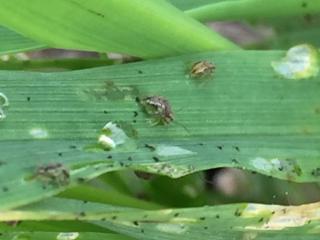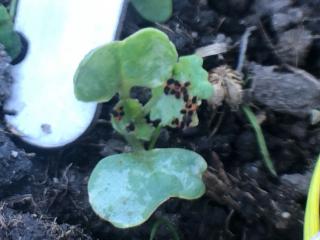Redlegged earth mites and lucerne flea are being found in high numbers in sprayed crops
- Merkanooka/Morawa
- Westdale
- Cadoux
- Dowerin
- Meckering
- Cunderdin
- York
- Beverley
- Brookton
- Narrogin
- Wickepin
- Williams
- Wandering
- Crossman
- Darkan
- Boyup Brook
Redlegged earth mites (RLEM) and lucerne flea continue to damage young crops, and in some cases have escalated in numbers even in crops which have received a pre-sowing and/or post sowing pre-emergence insecticide application.
Farmer Zak Valentine has sprayed his cereal crops at Merkanooka (west Morawa) this week for lucerne flea where they were in high numbers, especially in paddocks which were fallow last year and/or on heavy soils. Zak noted that his canola crops which were sprayed with chlorpyrifos and bifenthrin about 3 weeks ago do not seem to have damaging levels of RLEM.
A farmer at Westdale has reported very high numbers of RLEM in his canola which was sprayed with 80 mL of Talstar® (bifenthrin 250 g/L) presowing and a second application of 40 mL/ha Talstar® post sowing in early June. The paddock was in barley last year and the farmer will spray chlorpyrifos now to protect the crop.
Research officer Pip Payne (DPIRD) has found lucerne flea feeding on oats at an oat trial site near Cunderdin. The site will be sprayed with Le-Mat® to prevent further damage.
David Stead (Anasazi Agronomy) is seeing RLEM and lucerne flea in high numbers in cereal and canola crops from Cadoux through down to Brookton. David said more than 50 RLEM per plant are not hard to find. David was also concerned that crops had been sprayed one or more times so far and the insecticides were not controlling populations. Interestingly, Dave noted that very high numbers tended to be in crops that were in fallow or pasture last year, but also that growers that used a Timerite® spray in spring last year usually had reduced numbers of RLEM.
Hilary Wittwer (Planfarm) has also recently seen high numbers of RLEM and lucerne flea in cereal and canola crops near Narrogin, Wickepin, Williams and Wandering. Hilary commented that crops are very wet and some are currently impossible to get a boom spray onto.
An Agworld user has reported finding RLEM in oats near Crossman.
Jessica Brown (Kalyx) reports that RLEM and lucerne flea were damaging canola at Darkan.
Ben Creek (AGRIvise) has reported that cotyledon to 8 leaf canola crops in the Boyup Brook area are being damaged by RLEM and vegetable weevils. Lucerne flea are also a problem in the Boyup Brook area especially in clover paddocks and canola crops that have had late and staggered germination.
Why is this happening?
Late season starts like this are frustrating for pest management because the late rains, slow plant germination and delayed mite and lucerne flea egg hatchings mean that the usual tactics of tank mixing insecticide with herbicide do not control the mite and lucerne flea populations.
RLEM and lucerne flea can also hatch outside of the window of insecticide efficacy.
Heavy rains can also affect the efficacy of spays.
This combination of factors often results in high to sometimes very high numbers of RLEM and/or lucerne flea in crops at this time of year when sprays applied weeks ago are no longer effective enough to bring those populations down.
Adding to the frustration is that some populations of RLEM in WA have developed resistance to the commonly used synthetic pyrethroids (SP’s; e.g. Talstar®) and organophosphates (e.g. Le-Mat®). However, in most cases where RLEM and lucerne flea are surviving sprays they are simply not coming into contact with a lethal dose of insecticide because of the spray choice, spray date relative to egg hatch, and other agronomic conditions including heavy rain.
It is also worth noting that lucerne flea do not respond well to SP’s so this is sometimes why lucerne flea are surviving and damaging crops after an SP spray.
Both RLEM and Lucerne flea will attack all crop and pasture species, however lucerne flea tend to damage cereals more than RLEM.
For insecticide recommendations for managing lucerne flea and RLEM refer to DPIRD’s 2019 Autumn/Winter Insecticide Guide.
Testing available for insecticide resistance in redlegged earth mite
Growers who notice reduced chemical efficacy or suspect insecticide resistance in RLEM are now able to test for resistance.
DPIRD is again making available a screening service to growers and consultants to test for insecticide resistance in RLEM, following previous screening in 2017.
The free-of-charge service, made possible with investment by the Grains Research and Development Corporation (GRDC), is led by The University of Melbourne, in collaboration with DPIRD, cesar, and CSIRO.
Growers who find RLEM that survive registered rates of insecticide treatments are encouraged to arrange for resistance testing to be conducted by contacting DPIRD entomologist Svetlana Micic, Albany on +61 (0)8 9892 8591 or 0427 772 051.
For more information refer to GRDC’s RLEM Resistance Management Strategy, and the IPM Guidelines for Grains website.
For more information about diagnosing and managing RLEM and lucerne flea refer to DPIRD’s Diagnosing redlegged earth mite and Diagnosing lucerne flea pages.
For more information on invertebrate insects contact Dustin Severtson, Development Officer, Northam on +61 (0)8 9690 2160 or Svetlana Micic, Research Officer, Albany on +61 (0)8 9892 8591 or Alan Lord, Technical Officer, South Perth on +61 (0)8 9368 3758.


